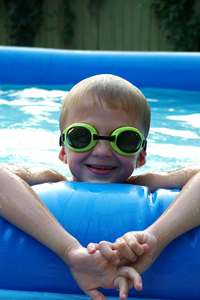Make a Safe Splash This Summer

Children can drown in as little as three inches of water.
Every day about 10 people die from unintentional drowning. Of these, two are children aged 14 or younger. The Centers for Disease Control and Prevention states that drowning ranks fifth among the leading causes of unintentional injury death in the United States.
Ron Cook, D.O., Texas Tech Physicians Family Medicine, said this summer keep cool, but be aware of the dangers of the water.
“Every year almost 400 deaths a year are related to drownings, usually within 25 feet of an adult,” Cook said. “Parents and adults need to keep an eye on children at all times when they are in the water. Movies tell us that everyone splashes and screams when they drown. But it is the opposite. Usually the person is very quiet and trying to keep their head above the water and breathe.”
Cook said it is difficult to see a drowning victim because of the glare on the water and the refraction of light. Many times a victim may be on the bottom of the pool.
“Every year drownings take second place only behind care accidents for traumatic death with children," Cook said. "Parents need to take precautions to keep their children safe in the pool, at the lake or at the beach. Remember that wading pools are dangerous as well. Children can drown in as little at three inches of water because toddlers can climb in easily."
Cook said to make sure to dump wading pools immediately after use to assure a toddler’s safety. He also gives these water safety tips:
- Floaties are not a substitute for a life jacket and nothing is better than adult supervision.
- Large pools should have a lockable gate and fence surrounding the pool, and a pool alarm in the pool itself.
- Know the signs of someone drowning. A person drowning cannot cry out or wave for help.
Cook said many people who are drowning will have an empty, unfocused look on their face, not using their legs vertically, gasping and have their head low in the water or appear to try to swim but are not moving forward.
"Just remember that normally children are having fun and making noise," he said. "If you notice them getting quiet, look for them and make sure they are okay. Make it a point to be vigilant and keep your eyes on them in the water."
Related
Give the Gift of Sight: Be an Eye Donor
Related Stories
Celebrating Veterans: TTUHSC’s General Martin Clay’s Legacy of Service and Leadership
From his initial enlistment in the Army National Guard 36 years ago to his leadership in military and civilian health care management roles, Major General Martin Clay’s career has been shaped by adaptability, mission focus and service to others.
Texas Tech University Health Sciences Center School of Nursing Named Best Accelerated Bachelor of Science in Nursing Program in Texas
The TTUHSC School of Nursing Accelerated Bachelor of Science in Nursing (BSN) program has been ranked the No. 1 accelerated nursing program in Texas by RegisteredNursing.org.
TTUHSC Names New Regional Dean for the School of Nursing
Louise Rice, DNP, RN, has been named regional dean of the TTUHSC School of Nursing on the Amarillo campus.
Recent Stories
Making Mental Health a Priority in the New Year
Sarah Mallard Wakefield, M.D., a psychiatrist with Texas Tech Physicians, talks about strategies to combat widespread and growing anxiety.
TTUHSC Cancer Researcher Honored by National Academy of Inventors
C. Patrick Reynolds, M.D., Ph.D., director of the School of Medicine Pediatric Cancer Research Center at TTUHSC, has dedicated his life as a researcher to developing treatments for childhood cancers.
TTUHSC School of Nursing Celebrates 10 Years of the Veteran to BSN Program
The TTUHSC School of Nursing recognized the 10-year anniversary of the Veteran to Bachelor of Science in Nursing (VBSN) program during the fall 2025 commencement ceremonies held Dec. 13 in Lubbock, Texas.
